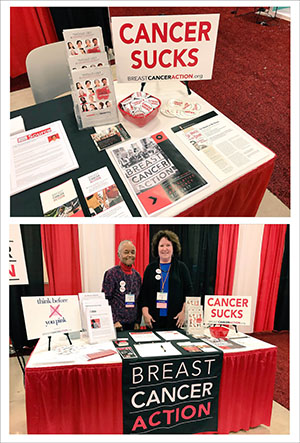By Karuna Jaggar, Executive Director
 It’s the first day of the San Antonio Breast Cancer Symposium (SABCS) and it’s already clear we’re going to run out of our trademark “Cancer Sucks” buttons. (Consider this my personal tip to you, if you’re here, to swing by Breast Cancer Action’s booth to get yours now.)
It’s the first day of the San Antonio Breast Cancer Symposium (SABCS) and it’s already clear we’re going to run out of our trademark “Cancer Sucks” buttons. (Consider this my personal tip to you, if you’re here, to swing by Breast Cancer Action’s booth to get yours now.)
SABCS is the world’s largest annual breast cancer conference. It’s grown over its 41 years and now brings together some 8,000 people from dozens of countries over five days.
Cancer Sucks is a unifier that brings knowing smiles between strangers and starts conversations with patient advocates, healthcare providers, researchers, and industry employees.
Statistics are important and I wouldn’t want to be accused of fudging the numbers, but a good number of those 8,000 people are wearing our Cancer Sucks buttons. Some folks even brought their own well-worn button from prior years—they are, unfortunately, never out of style.
I missed the SABCS conference myself last year (I’ve come every year since 2011 before that) because of my own (non-breast) cancer.
I wish I could say we could put our Cancer Sucks buttons away for good, that breast cancer has been cured and we know how to prevent it. Not yet. Not this year.
Unfortunately, SABCS doesn’t delve into true primary prevention, which is largely unfunded, except for an occasional study on chemoprevention and limited lifestyle research.
So what have we seen so far when it comes to new treatment options?
There were two studies that are being touted as establishing a new standard of care, which I’ll blog about separately. In the meantime, here’s the teaser of these two studies presented today:
And although no new evidence was presented today about areas where breast cancer patients can safely avoid treatments, avoiding overtreatment, it was notable that the topic came up several times. In fact, Dr. Eric Winer’s (Dana-Farber) talk for his Susan G. Komen Brinker Award was titled “The Challenge of Doing Less.”
Always talented at getting to the point, Dr. Laura Esserman (UCSF) succinctly summarized an afternoon presentation showing more treatment isn’t always better: adding therapy once you achieve pCR (however you get it) doesn’t help. The study (GS2-03) was a meta-analysis of 27,000 patients from 52 studies that evaluated pathological complete response (pCR) between 1999-2016. Researchers found that patients whose tumor responds completely to systemic therapy before surgery (pCR w/ neoadjuvant therapy), don’t live longer when they’re given more chemo after surgery. Most breast cancer trials focus on adding additional systemic therapies to reduce recurrence, but adding treatment adds toxicity. This study provides an important chance to reduce toxicity without negatively impacting survival outcomes.
Of course, what we really need is to do the right amount of the right things. Yes, we need to avoid overtreatment. We also need to remove barriers to timely, affordable, evidence-based treatment. And we need true primary prevention so that fewer people need breast cancer treatment.
The conference opened officially this morning with the somber note that this year, for the first time, breast cancer surpassed lung cancer as the leading cancer death for women globally. It’s a #1 spot and top rank we definitely don’t want. And it will take both true primary prevention and more effective, less toxic, affordable treatments to change that stat.